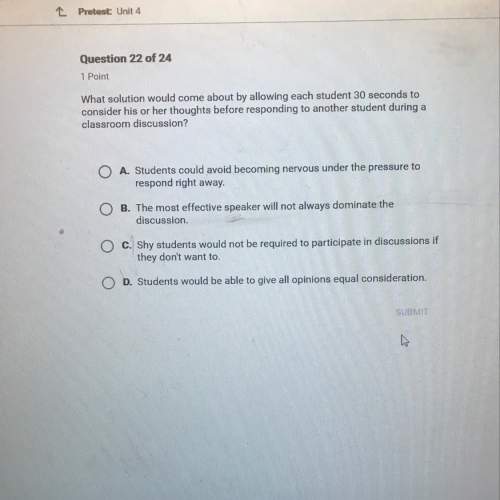
English, 17.02.2021 21:10 rubincain203
Presenting an Argument
In this task, you will present an argument on a topic related to fairness, equality, and justice.
Imagine that you have been asked to present an argument to your classmates. Choose one of the topics in the following list for your presentation:
Privacy fairness. The Fourteenth Amendment of the US Constitution helps protect the right of citizens to keep personal behavior and matters private. However, teenagers’ right to privacy is controversial due to the balance of teens’ rights versus parents’ duty to protect their children. Present an argument about whether teenagers should have the same right to privacy as adults.
Disability rights. The disability rights movement is meant to ensure equal opportunities for people with disabilities. Present an argument about whether people with disabilities need stronger protections under the law.
Marketing to youth. Technology has changed how advertising is delivered to the public, often allowing advertisers to specifically target children and teenagers. Present an argument about whether it is just to restrict advertising targeted to youth.
Part A: Planning and Organizing Your Argument
First, you’ll plan and organize your argument with these details in mind:
The purpose of this presentation is to make a claim that is reinforced by supporting details and evidence.
The audience is a group of peers or classmates.
The task is a classroom presentation.
In the following table, plan and organize your argument for the topic you selected. Be sure to include details for each part of your argument:
Claim. Create a claim or central idea for your argument.
Data. Support the claim with details and evidence.
Warrant. Explain how the details and evidence support the claim.
Counterclaim. Include a counterclaim that opposes the central claim.
Rebuttal. Provide evidence that negates the counterclaim.
Part B: Drafting Your Argument
Next, use the planner from part A to write a draft of your argument in the answer space. Remember, your audience should be able to follow your line of reasoning. Be sure to organize the argument clearly, concisely, and logically.
Tip: Remember to include transitions in your presentation. Focus on spoken transitions as you write your draft. You can add visual transitions in part C, when you create your presentation.
Part C: Adding Strategic Digital Media
Now you’ll create your presentation. Use a presentation software program or other presentation tools that are available to you. Refer to the outline you created in part A as well as your draft from part B as you design your presentation.
In the answer space, note one to three types of media you will use for each section of your argument:
introduction
body
conclusion
TIP: Remember, different types of media include text, images, charts and graphs, audio, video, and animation.
Be sure that the media you choose to include is both strategic and creative. Strategic and creative media will not only help your audience understand your argument, but it will also keep them engaged in the presentation.
Part D: Presenting Your Argument
Now, it’s time to deliver your presentation. Follow these steps:
Review the presentation rubric to prepare for your presentation. It also may be helpful to review this video on presentation techniques.
Start practicing your presentation. You can practice in front of a mirror, ask a friend or family member to be a test audience member, or record yourself on video.
When you’re ready to present your argument, be sure to check with your teacher about how to present or document your presentation for evaluation.
After you’ve given your presentation (as directed by your teacher), reflect on your performance using the presentation rubric. Write what you did well and how you could improve. Refer to criteria from the rubric in your response.

Answers: 1


Other questions on the subject: English

English, 21.06.2019 16:00, eldercunningham
Why is emerson’s essay “self-reliance” a great example of transcendentalism?
Answers: 2

English, 21.06.2019 16:30, lelliott86
“unlike my opponent, i propose freedom from crime, freedom from poverty, and freedom from unemployment “ what rhetorical approach is the speaker most likely to be talking in this sentence? a. the speaker wants the audience to question the meaning of freedom and redifine it. b. the speaker wants the structure of this sentence to stand out in the listeners minds. c. the speaker wants to anticipate and address w counter-argument from his or her opponent. d. the speaker wants to transition into a topic that is largely unrelated to previous topics.
Answers: 1


English, 22.06.2019 00:20, mshepherdmiller
How did chesterton’s “the fallacy of success” fit into a broader trend in european thought? what was chesterton’s viewpoint on success? your answer should be at least one hundred words.
Answers: 3
You know the right answer?
Presenting an Argument
In this task, you will present an argument on a topic related to fairness, e...
Questions in other subjects:

Mathematics, 19.07.2019 10:30




History, 19.07.2019 10:30



Biology, 19.07.2019 10:30

Mathematics, 19.07.2019 10:30




